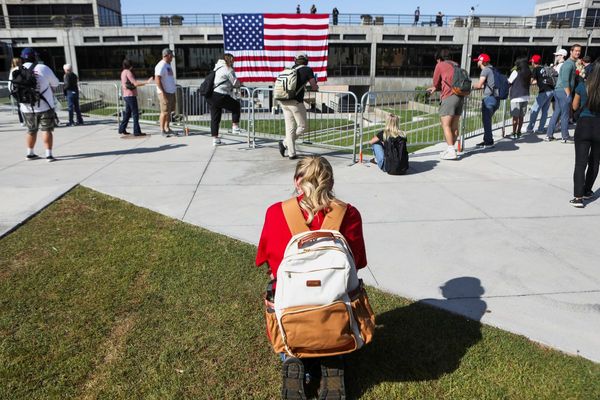The Federal Reserve delivered its first interest-rate cut of the year on Wednesday and bolstered hopes for further rate cuts in October and December. After the 2 p.m. ET policy statement, the S&P 500 traded fractionally higher in afternoon stock market action as Fed chief Jerome Powell painted a cautiously upbeat picture of where the economy stands. Nvidia and Uber fell while Tesla erased early losses.
What Wall Street really wanted to know was whether the Fed saw this as the first cut of a bunch or whether we could quickly be back in wait-and-see mode. New quarterly projections lean toward the former scenario, but Powell tried to erode that perception, highlighting significant support on the Fed for just one more cut this year. The Fed remains in a "meeting-by-meeting situation," he said.
3:15 p.m. ET
S&P 500 Turns Green As Powell Wraps Up
As Powell's news conference ended, the S&P 500 edged into positive territory, up about 0.1%. Markets currently see 89% odds of a further quarter-point rate cut on Oct. 29 and 83% odds that the Dec. 10 meeting will bring a third-straight rate cut.
However, odds of a third straight cut at the December meeting had spiked to around 93% before Powell worked to instill some doubt about the rate-cut trajectory.
3:05 p.m. ET
AI's Labor-Force Impact
Powell's guess: You are seeing some effect. "That may be part of the story," especially with young people coming out of college.
Stocks Hold After Fed Whipsaw; Two Dow Giants Diverge
3:04 p.m. ET
Powell Is Upbeat Overall
Unemployment crept up but is low. GDP growth is looking a bit better. Inflation seems to be working through the imposition of tariffs without major fallout, though it's too soon to give the all-clear signal.
3:01 p.m. ET
Powell Addresses Big Downward Job Revisions
Powell highlighted low response rates to surveys as the primary problem. He said the agencies need sufficient resources to improve response rates, implying they could use more.
2:56 p.m. ET
Powell Highlights Low Hiring
Powell highlighted "kids coming out of college" and minorities as two groups that are seeing worse labor market outcomes. The concern, he said, is that people who are laid off will have trouble finding jobs.
2:55 p.m. ET
'A Meeting-By-Meeting Situation'
Powell is trying to explain why markets shouldn't be too confident that the Fed will cut by an additional 50 basis points this year. Powell noted that nine FOMC members indicated just one more cut this year. The Fed remains data dependent.
2:47 p.m. ET
Stocks Weaken, Bond Yields Rise
The S&P 500 fell 0.7% as Powell continued speaking, while the Nasdaq lost 1.1%. The Dow Jones clung to a fractional gain. The 10-year Treasury yield, which briefly undercut the 4% level, rebounded to 4.07%.
2:43 p.m. ET
Should Fed Enter The Neutral Zone?
Powell wasn't willing to go that far. He said it's appropriate for rates to be moving closer to neutral, but not necessarily all the way.
2:41 p.m. ET
Are Tariffs To Blame For Slower Labor Market?
"It's certainly possible," Powell said, in response to the question. However, Powell said the biggest shift in the labor market relates to the declining supply of workers.
2:38 p.m. ET
Balancing Fed's Two Mandates
Fed is taking another step toward a more neutral policy stance, Powell said, because the balance of risks has shifted with the softening of the labor market.
2:37 p.m. ET
Goods Vs. Services Inflation
"Disinflation appears to be continuing for services" even as goods inflation has picked up.
2:34 p.m. ET
Powell: Business Investment Picks Up
Business investment has picked up even as consumer spending has slowed. The Fed now sees GDP growth of 1.8% next year, up from a prior forecast of 1.6%.
2:31 p.m. ET
Fed Projections For 2026 Don't Jibe With Markets'
CME Group shows the federal funds target rate falling a bit below 3% next year vs. the Fed projection of 3.375%. A key question that Powell may address is where the Fed now sees the neutral interest rate, one that neither boosts nor constricts economic growth.
11:28 p.m. ET
Fed Rate-Cut Odds Step Up
Rate-cut odds leapt to get more in line with Fed projections for this year. CME Group's FedWatch tool now shows 93% odds of a total 75 basis points in rate cuts this year, up from 73% before release of the Fed projections.
2:23 p.m. ET
Trump's Fed Fight Looms Large For 2026
President Trump's effort to remove Fed Gov. Lisa Cook, a Biden appointee, could lead to easier monetary policy next year, if he succeeds. So far, the Trump administration hasn't been able to prove its case but the battle continues. The Fed projections show that nine policymakers believe the key rate should fall at least to the 3%-to-3.25% range next year. For now, the median projection is for the federal funds rate to fall to a range of 3.25% to 3.5% in 2026, but it would take just one vote to bring the median a step lower.
Median projections are of modest value, since they're projections, not a plan, as Chairman Jerome Powell frequently says. Further, only 12 of the 19 FOMC members get a vote each meeting.
2:18 p.m. ET
Sell The News? S&P 500 Turns Lower
The S&P 500, after briefly advancing, is down 0.2%, with the Nasdaq sliding 0.7%. The Dow Jones is still up 0.7%. The 10-year Treasury yield has reversed lower, to 3.99%.
2:16 p.m. ET
Only One Fed Dissent
Trump economic adviser Stephen Miran, the newest member of the Fed's policy-setting committee, was the only one to dissent from the policy statement, preferring a 50-basis-point rate cut to a quarter-point.
2:11 p.m. ET
Fed Projections: Better Unemployment, Worse Inflation
Given the sharper expected rate cuts this year, it's a bit surprising that the Fed's outlook for unemployment is a touch better than it was in June, with the rate expected to rise to 4.5% this year, before easing to 4.4% next year. Prior projections showed 4.5% unemployment holding through the end of 2026.
On the other hand, core PCE inflation is seen easing to 2.6% next year from 3.1% at the end of this year. Prior projections showed core PCE inflation falling to 2.4% next year.
2:08 p.m. ET
Fed Rate-Cut Projections
The new quarterly projections showed the federal funds rate easing to 3.6% by year end. That means three quarter-point rate cuts for the year, which will drop the target federal funds rate to a range of 3.5% to 3.75%.
The projections pencil just one further quarter-point rate reduction in 2026, leaving the key rate at a range of 3.25% to 3.5%.
2:05 p.m. ET
Fed Cuts Rates By 25 Basis Points
The Fed cut its key rate by a quarter point, as expected, to a target range of 4%-4.25%. Policymakers pointed to 50 basis points in in further cuts by year-end.
The S&P 500 rose 0.2% after falling a fraction just before the 2 p.m. ET announcement.
1:28 p.m. ET
Stocks Mixed Heading Into Fed Announcement
The S&P 500 fell 0.2% and the Nasdaq sank 0.5%, with Nvidia stock and Uber notable losers. The Dow Jones climbed 0.5% and the small-cap Russell 2000 advanced 0.7%.
The 10-year Treasury yield rose two basis points to 4.045%, still near five-month lows.
FOMC Policy Statement And Projections
The Fed's policy-setting panel, the Federal Open Market Committee (FOMC), will release its policy statement announcing any changes to the federal funds rate or its policy of gradually shrinking its balance sheet.
Beyond the expected quarter-point rate cut, markets are pricing in a strong likelihood (73% odds) of an additional 50 basis points in rate cuts this year. That suggests further 25-basis-point cuts at the coming Fed meetings on Oct. 29 and Dec. 10, which would leave the target federal funds rate at a range of 3.5% to 3.75%.
The new batch of quarterly projections will indicate if policymakers are in sync with market expectations. The June projections penciled in a total of 50 basis points in rate cuts this year to a range a of 3.75% to 4%. But those projections were made before job growth tanked and the unemployment rate ticked up to 4.3%, the highest since late 2021.
As of June's projections, the median Fed policymaker expected the federal funds rate to fall by only an additional quarter-point in 2026 to around 3.6%. But market pricing now shows the Fed's key rate falling to a bit below 3% next year.
Powell's Take: 'Midcycle Adjustment' Or More?
Powell's speech at the Kansas City Fed's annual symposium in Jackson Hole, Wyo., on Aug. 22 indicated that growing downside risk to the labor market had cleared the threshold for cutting rates. Labor market weakness was now at least as big of a risk as too-high inflation. However, Powell stopped short of telegraphing a series of rate cuts.
The question now is whether the even-softer August jobless report and relatively benign inflation data will lead the Fed to signal a likelihood of multiple rate cuts still to come. That's largely what markets are expecting, so it might be a bit of a downer if Powell pulls out his "midcycle adjustment" formulation from 2019.
After the Fed cut rates in July 2019 for the first time in over seven years, Powell characterized it as a "midcycle adjustment" rather than "the beginning of a lengthy cutting cycle," which prompted a knee-jerk stock market downdraft.
Still, the Fed ended up cutting by 75 basis points in three straight meetings.
Trump's Fed Fight
The subtext of today's Fed meeting update and projections is that President Trump is trying everything possible to push the Fed in a more dovish direction. With Trump economic adviser Stephen Miran taking part in his first Fed meeting after being appointed as one of seven governors, it's possible that at least three FOMC participants will dissent from a vote to cut rates by a quarter point.
Miran could join prior Trump appointees Michelle Bowman and Christopher Waller in backing a half-point cut.
Trump's power to influence Fed policy will depend largely on what happens with his effort to fire Fed Gov. Lisa Cook on unproven allegations she submitted misleading mortgage documents. Cook, who was tapped by Biden and confirmed by the Senate, is currently one of four Fed governors who appear to be out of Trump's sphere of influence.
But if Trump succeeds in pushing her out, which he'll likely need the help of the Supreme Court to do, he'd gain sway over the appointments of the 12 Fed regional bank presidents, five of whom get to vote at each Fed meeting. The regional Fed presidents' terms expire at the end of February and they'll need support of a majority of Fed governors to stay in their posts.







